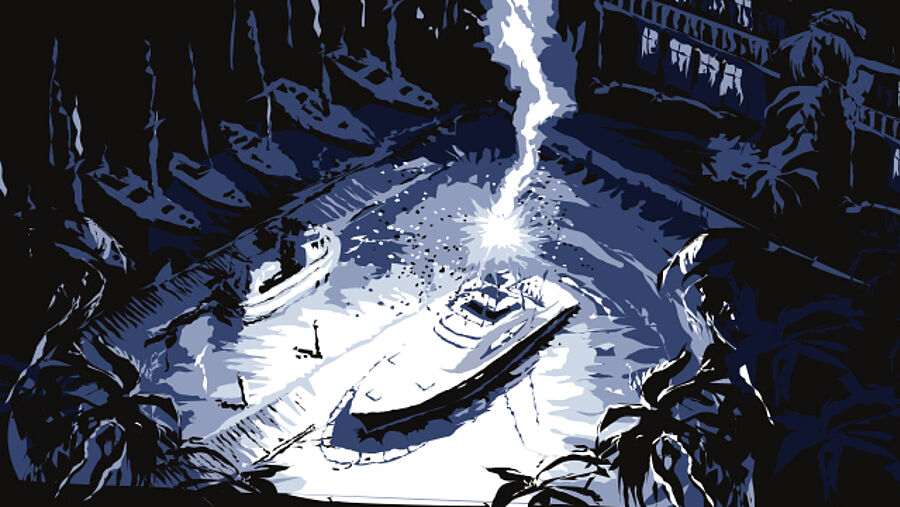
* Pantaenius UK Limited is authorised and regulated by the Financial Conduct Authority (Authorised No.308688)
As your skipper or charter insurances contracts have been concluded in Germany, you will first be redirected to the website of Pantaenius GmbH, Germany. Please follow the link-button to log in to your account.
Login Skipper & ChartererOpen waters are not exactly the place you want to be caught off guard by a thunderstorm. On a sailing boat, quite often, the mast is the tallest object by far and wide, and most times lightning chooses the tallest spot in its surroundings. Admittedly, the probability that a sailing boat is struck by lightning is fairly small – hence scare stories would be misplaced, yet the odds and the damage potential are high enough to pay some more attention to this issue, as Axel zu Putlitz-Lürmann, claim expert with insurance specialist Pantaenius explains:

While lightning protection systems for buildings are widely used , in boating sports their usage is not so common yet. Other than mega yachts, which are often built according to class guidelines and hence are equipped by standard with an appropriate protection system, usually stock-built yachts are not protected by any particular equipment. There are no binding standards and guidelines for lightning protection systems. Hence, the owner must take care of a correct protection equipment himself. This, however, is hardly feasible for a nonprofessional.
Lightning protection for a yacht is a complex issue, which requires a lot of know-how
as Mr zu Putlitz-Lürmann states. "Even though there is some specialist literature from many different fields, but an effective later retrofitting of yachts is always difficult, laborious and potentially very costly." However, since nowadays the yachts are equipped with extensive navigation electronics and on-board technology, the investment might still be worth it. "While 20 years ago many owners had only little electronic equipment consisting of stand-alone devices such as VHF marine radio, logs, echo sounder and a weatherfax on board, these days the yachts are crammed with high tech – e.g. GPS, sea chart plotters, AIS, autopilot, satellite communication, radar, fishfinder and entertainment systems. "It is disastrous that often many or even all devices are connected via bus system. In case of a lightning strike, the lightning power can rush through the entire network and damage all devices" describes the Pantaenius claim expert.
But not only the technical devices are threatened. Structural damages to the boat right up to a total loss may be caused by a lightning strike. "A lightning takes the line of least resistance towards the earth potential. If it encounters such resistance, masts can burst, rudder blades be split and hull or keel coverings can literally be blasted off", Mr zu Putlitz-Lürmann explains, who has already inspected many lightning damages/claims?
Whether or not a lightning strikes, cannot be influenced by a lightning protection system. However by lightning protection measures the point of impact and the path the lightning power takes can be controlled by conducting and earthing it. A lightning's electric current is usually approx. 20,000 to 50,000 amperes, in exceptional cases up to 100,000 amperes; already 0.3 ampere can be fatal. This enormous electric power needs to be conducted into the water via the most simple, swift and short path possible via sufficiently sized conductors. This is not a big problem with steel and aluminum yachts. For wooden or GFK vessels this is more difficult.
A simple, but more of a makeshift solution is a system consisting of copper conductors and clamping fixtures, which can be fastened to the mast, the shrouds and stays. The loose ends of the cables are hung 1.5 m deep into the water, in order to conduct the lightning into the water. In theory, this sounds logical but certainly, this cannot grant any full protection. Because a lightning's behavior is very complex, it splits, flashes over and can even get back from the water on board. Additionally there is the danger of lightning strike from outside, typically via the shore connection unit in the harbor, which will strike directly into the electrical system and damage it. The conclusion: if you think about putting into practice an effective, full lightning protection for your yacht, in any case you should consult a specialist: for a newbuilding as well as for retrofitting a second hand boat.
Whatever the lightning protection of your yacht may look like: First priority should be protection of life and limb: if a thunderstorm is approaching, therefore there are specific measures you should take to heart: